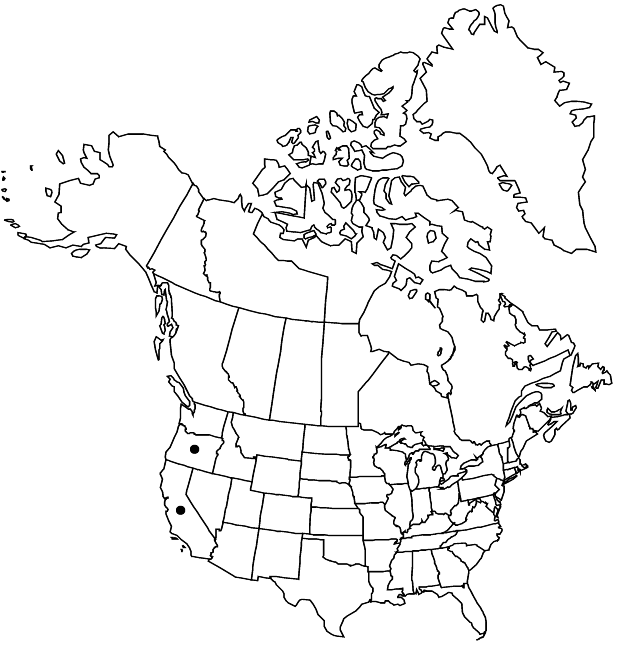Difference between revisions of "Lithophragma campanulatum"
Fl. N.W. Amer., 200. 1898 (as campanulata) ,.
FNA>Volume Importer |
imported>Volume Importer |
||
| (6 intermediate revisions by 2 users not shown) | |||
| Line 7: | Line 7: | ||
}} | }} | ||
|common_names=Siskiyou Mountain woodland star | |common_names=Siskiyou Mountain woodland star | ||
| + | |special_status={{Treatment/ID/Special_status | ||
| + | |code=E | ||
| + | |label=Endemic | ||
| + | }} | ||
|basionyms= | |basionyms= | ||
|synonyms={{Treatment/ID/Synonym | |synonyms={{Treatment/ID/Synonym | ||
|name=Lithophragma laciniatum | |name=Lithophragma laciniatum | ||
|authority=Eastwood ex Small & Rydberg | |authority=Eastwood ex Small & Rydberg | ||
| + | |rank=species | ||
}} | }} | ||
|hierarchy=Saxifragaceae;Lithophragma;Lithophragma campanulatum | |hierarchy=Saxifragaceae;Lithophragma;Lithophragma campanulatum | ||
| Line 26: | Line 31: | ||
|elevation=100-2200 m | |elevation=100-2200 m | ||
|distribution=Calif.;Oreg. | |distribution=Calif.;Oreg. | ||
| − | |discussion=<p>Lithophragma campanulatum is known from the Siskiyou Mountains, adjacent Klamath and Cascade mountains, and adjacent Sierra Nevada in northern California and southern Oregon.</p> | + | |discussion=<p><i>Lithophragma campanulatum</i> is known from the Siskiyou Mountains, adjacent Klamath and Cascade mountains, and adjacent Sierra <i>Nevada</i> in northern California and southern Oregon.</p> |
|tables= | |tables= | ||
|references= | |references= | ||
| Line 35: | Line 40: | ||
-->{{#Taxon: | -->{{#Taxon: | ||
name=Lithophragma campanulatum | name=Lithophragma campanulatum | ||
| − | |||
|authority=Howell | |authority=Howell | ||
|rank=species | |rank=species | ||
| Line 49: | Line 53: | ||
|publication title=Fl. N.W. Amer., | |publication title=Fl. N.W. Amer., | ||
|publication year= | |publication year= | ||
| − | |special status= | + | |special status=Endemic |
| − | |source xml=https:// | + | |source xml=https://bitbucket.org/aafc-mbb/fna-data-curation/src/2e0870ddd59836b60bcf96646a41e87ea5a5943a/coarse_grained_fna_xml/V8/V8_157.xml |
|genus=Lithophragma | |genus=Lithophragma | ||
|species=Lithophragma campanulatum | |species=Lithophragma campanulatum | ||
Latest revision as of 23:41, 5 November 2020
Plants slender to robust. Flowering stems often branched, 25–45 cm. Leaves in basal rosette and cauline, basal 3-lobed, cauline (1–2), 3-lobed, reduced, more finely dissected than basal; stipules small, not decurrent on petiole, (margins raggedly fimbriate); petiole 4–8 cm; blade dark green or reddish green, orbiculate, (base rounded), surfaces moderately hairy. Inflorescences 1–3, (lax), erect, 2–11-flowered racemes, sometimes branched, (10–25 cm). Pedicels shorter than hypanthium, (flowers ± sessile). Flowers persistent, fragrant, pendulous; hypanthium broadly campanulate, elongating slightly in fruit, throat not constricted, (length 2 times diam.); sepals erect in bud, widely spreading after anthesis, triangular; petals (partly included), spreading, white, ovate-elliptic, lamina tonguelike, narrowly clawed, palmately lobed, 3–7 mm, ultimate margins lacerate; ovary superior; styles well exserted in fruit; stigma papillae apical. Seeds 0.6 mm, tuberculate (tubercles in 3–19 distinct rows, blunt).
Phenology: Flowering Apr–Jul.
Habitat: Well-drained, moist, semishaded slopes with northern exposure, oak-coniferous woodlands
Elevation: 100-2200 m
Discussion
Lithophragma campanulatum is known from the Siskiyou Mountains, adjacent Klamath and Cascade mountains, and adjacent Sierra Nevada in northern California and southern Oregon.
Selected References
None.
